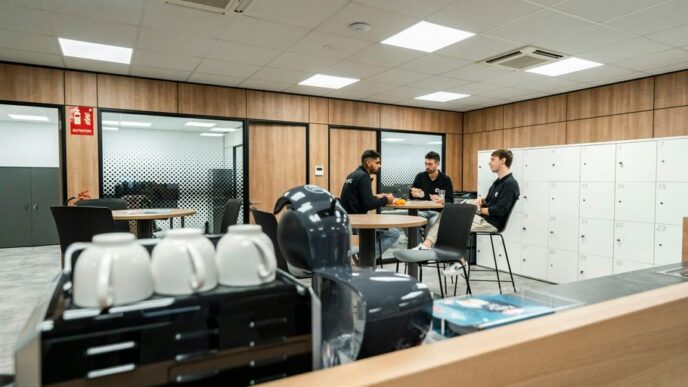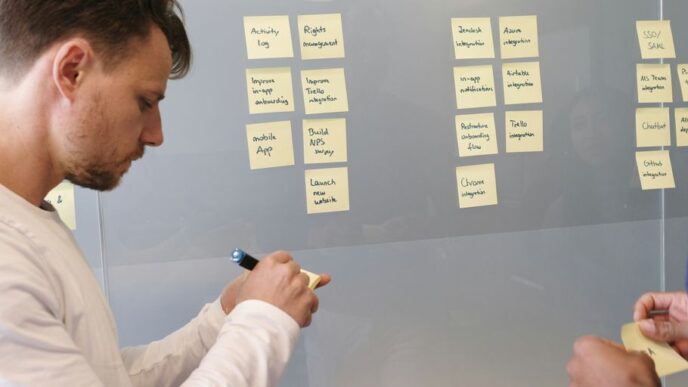So, EmTech AI is coming up soon at MIT, and it sounds like it’s going to be a pretty big deal for anyone interested in where artificial intelligence is headed. They’re talking about everything from superintelligence and how to keep AI safe, to how robots might start showing up in our daily lives. Plus, they’re digging into the business side of things – like how companies can actually use AI without running into a bunch of problems, and what the future looks like for tech that isn’t AI, like quantum computing. It’s all happening on the MIT campus, so you know it’s going to be grounded in some serious innovation.
Key Takeaways
- MIT’s campus is the setting for EmTech AI, bringing together leaders to discuss new ideas in tech.
- The event will cover major AI topics, including superintelligence, AI safety, and the rise of humanoid robots.
- Sessions will focus on practical ways businesses can adopt AI responsibly and manage expectations.
- Discussions will also explore the global side of AI, like national strategies and algorithm politics.
- Beyond AI, the conference will touch on other big tech areas like quantum computing and the future of work.
EmTech AI: Navigating the Future of Innovation
This year’s EmTech MIT event is all about helping business leaders figure out where things are headed, especially with all the fast changes happening in technology. It’s easy to feel a bit lost with new developments popping up constantly, but this conference aims to give you a clearer picture. The goal is to move from just guessing to actually knowing, so you can spot chances to make your business better and move forward with more certainty.
The MIT Edge: An Environment of Groundbreaking Ideas
Being on the MIT campus itself is a big part of the experience. For ages, this place has been where big ideas in science and tech get started, tested, and made better. It’s like stepping into a place that’s practically built for innovation. You get to learn right where a lot of world-changing stuff has come from.
Pioneering Minds: Connecting Industry Leaders
This event brings together about 400 people who are making decisions in different industries. It’s a chance to connect with others who are also thinking about what’s next. You’ll be in a group that can challenge your ideas and help you think in new ways. It’s not just about listening; it’s about talking with people who are in similar roles.
Editorial Authority: Insights from MIT Technology Review
Everything you hear at the sessions is put together by the people at MIT Technology Review. These are journalists who spend their days researching and writing about the technologies that are changing how business and the world work. They know what’s important and can explain it clearly. You can check out their coverage of EmTech Europe 2025 for a taste of their approach.
Key Themes and Sessions at EmTech MIT 2025
This year’s EmTech MIT 2025 is really zeroing in on what’s next in the world of artificial intelligence and other big tech shifts. It feels like they’ve picked out the topics that are actually going to change how we live and work, not just the buzzwords. The agenda is packed with sessions that look at AI from all angles, from the really big picture stuff like superintelligence and making sure AI is safe, to how AI is going to change business and even how we own things online.
The Next Intelligence: Superintelligence and AI Safety
This session is all about the future of AI, especially when we start talking about systems that are smarter than us. It’s not just about how smart they’ll be, but also how we make sure they’re safe and don’t cause problems. It’s a pretty heavy topic, but important.
The Protocol Economy and Decentralized Ownership
Here, they’re looking at how new internet systems, often called Web3 or the read-write-own model, are changing who controls what. Think about owning your digital stuff instead of a company owning it for you. It’s about building a more open internet.
Climate Tech’s Next Playbook for Sustainable Innovation
With climate change being such a big deal, this session focuses on new ways to use technology to help the environment. It’s about finding practical, scalable solutions, especially when money for new ideas might be tight. They’re talking about real strategies for green tech.
The Rise of Humanoid Robots in Everyday Life
Remember those sci-fi movies with robots doing chores? This session is about making that a reality. It’s exploring how humanoid robots are moving from factories into our homes and workplaces, and what that means for us. It’s interesting to see how close we are to that future. It seems like the focus is on practical applications and making these advanced technologies work for us. You can find more details about the event at MIT Technology Review’s flagship event.
Driving AI Adoption with Responsibility and Strategy

Getting AI into the hands of businesses and making sure it’s used right is a big deal. It’s not just about having the latest tech; it’s about using it smartly and safely. We need to think about how AI affects people and society, not just profits. This means building AI systems that are reliable and that we can actually understand.
When we talk about putting AI to work, there are a few key things to keep in mind:
- Think about the risks: Just like in finance, where they’re careful with money, we need to be careful with AI. This means having plans for what could go wrong and how to handle it. It’s about making sure AI helps, not hurts.
- Be open and honest: People need to know how AI systems work, especially when they make decisions that affect us. This builds trust. We need clear rules and ways to check that AI is doing what it’s supposed to.
- Make it work for innovation: The goal isn’t to stop new ideas, but to help them grow. Good AI use should make it easier to create new things and solve problems, not create more hurdles. It’s about finding that balance.
For example, think about facial recognition. It can be super useful for things like making customer service smoother, but we also have to think about privacy. How do we use it for business value without stepping on people’s rights? It’s a tricky line to walk, and companies need to have clear strategies for deploying this technology responsibly.
Then there’s the idea of AI systems acting on their own, which is called autonomy. Making AI that can do things without a person telling it what to do every step of the way is complicated and costs a lot. But these smart machines are changing everything, so we need ways to make AI-powered autonomy faster and better. This will really shape how industries work in the future, and we need to make sure there are rules in place for these autonomous actions.
Unpacking the Geopolitics and Algorithms of AI
It’s getting pretty complicated out there with AI, isn’t it? We’re not just talking about code anymore. Countries are really starting to think about how AI fits into their national plans, and that brings up a whole lot of questions about power and control. It’s not just about who builds the best AI, but who gets to set the rules for how it’s used, and what happens when different countries have very different ideas about that. This is where understanding the global picture becomes really important.
Mapping Sovereign AI Strategies
Different nations are looking at AI and thinking, "How do we make sure this works for us?" This means they’re developing strategies to control their own AI development and use. Think about data privacy, national security, and even economic competitiveness. Some countries want to build their own AI capabilities from the ground up, while others are looking to partner or acquire technology. It’s a complex dance, and everyone’s trying to get ahead.
Understanding the Geopolitics of Algorithms
Algorithms are no longer just neutral tools. They can reflect the biases of their creators and the data they’re trained on, and when these algorithms are used across borders, they can have real-world impacts on people and societies. Who decides what an algorithm prioritizes? What happens when an algorithm used in one country is seen as unfair or even harmful in another? We’re seeing a lot of discussion about how to make sure these systems are fair and don’t create new kinds of divides. It’s a bit like trying to figure out the rules of a game that’s still being invented, and everyone’s watching to see who wins. You can find some interesting perspectives on how techno-determinist ideas can affect human progress at DeepSeek Shock.
The ABCs of AI: Algorithms, Borders, Control
So, we’ve got algorithms, which are the instructions for AI. Then we have borders, which are the lines we draw between countries and their rules. And finally, control, which is about who gets to make the decisions. When you put these together, you get a really interesting picture of how AI is shaping international relations. It’s about more than just the technology itself; it’s about how we manage it, who benefits, and what happens when different systems clash. It’s a conversation that’s only going to get bigger.
Realizing Tangible Value from AI Initiatives

It’s one thing to talk about AI, and it’s another to actually make it work for your business, right? A lot of companies are jumping on the AI bandwagon, but they’re finding it tough to see real results. This part of EmTech MIT 2025 is all about cutting through the noise and figuring out where AI is actually paying off right now. We’ll look at how to set goals that aren’t just wishful thinking and how to get past the usual roadblocks that stop new ideas from taking hold.
Identifying AI’s Greatest Returns
We’ll get into the nitty-gritty of which AI applications are giving businesses the biggest bang for their buck. It’s not just about the flashy stuff; it’s about practical improvements that you can measure. Think about how AI is changing customer service or making supply chains run smoother. We’ll explore real examples to show what’s possible.
Managing Realistic Expectations for AI Projects
Let’s be honest, sometimes the hype around AI gets ahead of itself. This section is about grounding those expectations. We’ll discuss how to properly scope AI projects so they’re achievable and how to track progress in a way that makes sense. It’s about understanding what AI can do, and just as importantly, what it can’t do yet. Getting this right is key to avoiding disappointment and building momentum.
Overcoming Inertia in AI Implementation
Even with the best plans, getting new technology adopted can be a real challenge. We’ll talk about the common reasons why AI initiatives stall – things like resistance to change, lack of clear communication, or not having the right skills in place. You’ll hear about strategies to get people on board and make sure AI gets integrated properly into how you do things. It’s about making AI a tool that helps, not a hurdle to jump over. We’ll also touch on how AI is changing how information is found, similar to how Google’s AI summaries are changing discover products.
Insights from the Newsroom on AI’s Shifting Landscape
Stepping into the newsroom with MIT Technology Review’s editorial team offers a unique look at how AI is changing things. They’re the ones who live and breathe this stuff daily, so hearing their take on the forces shaping the AI market is pretty insightful. It’s not just about the big picture stuff either; they’re talking about the companies that are really making waves with new AI models and what that means for everyone else.
Forces Reshaping the AI Market
It feels like every week there’s a new development in AI, and the market is definitely feeling the shifts. We’re seeing changes in how AI is being used across different industries, and that’s impacting everything from how businesses operate to what kind of jobs are available. It’s a lot to keep up with, honestly. The pace of change is really something else.
Rising AI Model Makers and Their Impact
Remember when it felt like only a few big names were in the AI game? That’s changing. There are new players emerging, building impressive AI models that are starting to get noticed. Their work could really shake things up, offering different approaches and maybe even better solutions than what we’ve seen before. It’s exciting to see who will rise to the top and how their creations will be used. You can find more on how AI is impacting organizations at MIT Technology Review.
Evolving Safety Concerns in Artificial Intelligence
As AI gets more powerful, the safety side of things becomes even more important. The discussions around AI safety are getting more serious, and rightly so. We need to think about how to make sure these systems are used responsibly and don’t cause unintended problems. It’s a complex area, and the conversations happening now are key to figuring out the best way forward.
Exploring Transformative Technologies Beyond AI
While AI is certainly the star of the show at EmTech MIT 2025, it’s not the only game in town. The conference also shines a light on other big shifts happening in tech that could really change things. Think about quantum computing, for instance. It’s still pretty early days, but the potential for solving problems that are way too complex for today’s computers is huge. We’re talking about things like developing new materials or even making drug discovery faster. It’s a complex field, but the progress being made is pretty remarkable.
Then there’s the whole area of digital trust and how we’re going to manage our information and identities in the future. With more and more of our lives moving online, making sure our data is secure and that we can trust the systems we interact with is becoming a major challenge. This includes looking at things like blockchain and other decentralized systems that aim to give individuals more control over their own information. It’s about building a more secure and transparent digital world.
Quantum Computing Advancements
The Future of Digital Trust and Decentralized Systems
Rethinking the Future of Work and Money
EmTech AI: Connecting with Experts and Peers
EmTech AI isn’t just about listening to talks; it’s about building connections. You’ll be in a room with about 400 other executives and leaders, all focused on similar challenges. It’s a chance to really talk shop and get different perspectives.
Networking Opportunities with Industry Leaders
Think of this as a prime spot to meet people who are actually doing the work. You can chat with speakers and other attendees during breaks and the evening reception. It’s a good way to find out what’s working for others and maybe even spark a collaboration.
Engaging with a Community of Forward-Thinking Executives
This event brings together a specific group – people who are making decisions and driving change in their companies. You’ll find a community that’s ready to discuss new ideas and push boundaries. It’s not just about hearing new things, but about sharing your own insights with peers who get it.
Exclusive Executive Roundtable Sessions
These smaller sessions are where the real conversations happen. You can get into the nitty-gritty of AI implementation and strategy with a focused group. It’s a more intimate setting to ask tough questions and get direct answers from both speakers and fellow executives. This is a great way to get a feel for the MIT Edge and what makes it special.
Looking Ahead: The EmTech MIT Takeaway
So, that was EmTech MIT 2025. It really felt like a snapshot of where we are with technology right now, especially with AI. We heard from some seriously smart people about everything from superintelligence to how robots might fit into our daily lives. The discussions about climate tech and new ways to own things online were pretty eye-opening too. It’s clear that MIT is still the place where these big ideas get talked about and figured out. The whole event was put together by the folks at MIT Technology Review, who really know their stuff when it comes to what’s next. It’s a lot to take in, but it gives you a good idea of what’s coming and how we might need to get ready for it.
Frequently Asked Questions
What is EmTech MIT?
EmTech MIT is a big meeting where smart people talk about new technology, especially Artificial Intelligence (AI). It’s held at MIT, a famous university known for great ideas. You can learn about the latest tech trends and hear from experts.
When and where is EmTech MIT 2025?
The event will happen from November 4th to November 6th, 2025. You can go in person to the MIT campus or watch online.
What are the main topics at EmTech MIT 2025?
This year, the main focus is on AI, but they will also discuss other cool technologies like robots that look like people, ways to help the planet using technology, and new kinds of computer power called quantum computing.
Who will be speaking at the event?
You’ll hear from people who are leaders in technology and business. Some have worked at places like MIT, Microsoft, and even the government. They will share their knowledge and what they think about the future.
Who should attend EmTech MIT?
The event is for people who make important decisions in companies, like bosses and experts. It’s a chance to meet other smart people, share ideas, and learn how to use new technology to make businesses better.
Are there opportunities to meet and connect with others?
Yes, there will be chances to meet and talk with other attendees and speakers. These meetings are a great way to make new connections and learn from each other.














